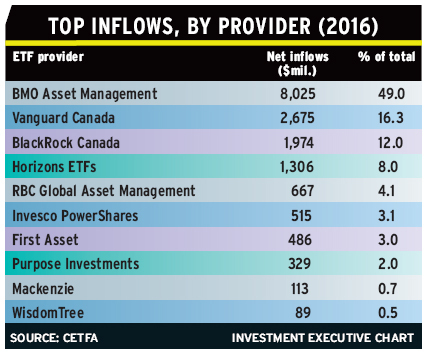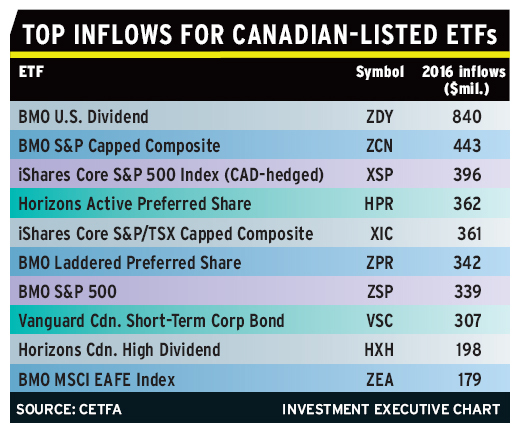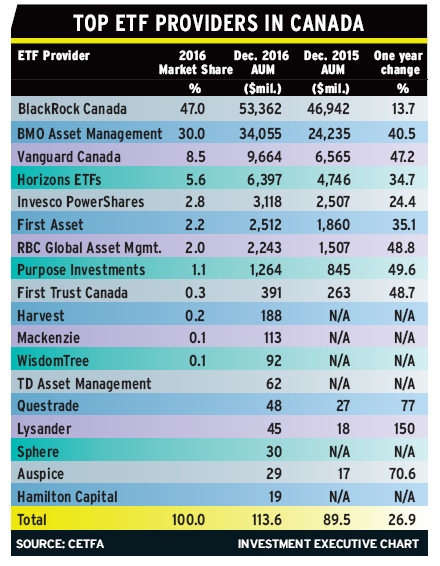
ETFs are continuing their relentless ascent in the world of financial products. Investors of all sizes and stripes are discovering ETFs’ myriad benefits, including low costs, transparency and easy access to a global smorgasbord of strategies and asset exposure.
“There’s been a lot of innovation in the marketplace, with ETFs offering new ways to optimize the risk/return relationship and access different investment sectors,” says Scott Boniferro, vice president of global investment strategies at PowerShares Canada, a division of Toronto-based Invesco Canada Ltd. “Investors are becoming more comfortable with the vehicle, and that’s leading to increased adoption and stimulating product development.”
ETFs have mushroomed on a global basis to US$3.8 trillion in assets under management (AUM), including $120 billion in Canada as of Feb. 28. For retail investors, whether they are tech-savvy millennials or retirees, buy-and-hold investors or aggressive speculators, ETFs provide quick access to diversified portfolios of securities across a range of global asset classes that previously were accessible only to high net-worth or institutional investors.
But even large institutions such as pension funds are finding that ETFs conveniently meet the need for both core and niche strategies, from cash-like securities to liquid alternatives. With a single purchase of a bond ETF, for example, an institution can gain access to a diversified bond portfolio faster and at a far more efficient price than by sourcing a comparable basket of individual bonds in the widely dispersed, opaque and often illiquid bond market. In the current low-yield environment, the cost savings inherent in ETFs are particularly relevant.
“ETFs are sparking a revolution in the investment world and are transforming the landscape,” according to Jim Ross, executive vice president with Boston-based State Street Global Advisors, speaking at the annual Inside ETFs conference in Florida earlier this year. (That conference, organized by ETF.com, attracted a record 2,300 attendees.) “ETFs have improved the ability of investors and advisors to create endlessly customizable portfolios suited to a variety of objectives at a low cost.”
However, Ross identified a growing shadow hanging over ETFs. As more products are introduced that deviate from traditional market-capitalization indices, ETFs are becoming increasingly complex and difficult to understand and explain to clients. ETFs aren’t just a simple way to obtain exposure to broad equities markets anymore. As well, telling clients to expect returns that mirror those of the index can be overly simplistic and not applicable to a given ETF. Now, ETFs are available across a spectrum that includes a range of “strategic beta” (a.k.a. smart beta or factor-based) and fully discretionary, active portfolio-management strategies that deviate from market cap-weighted indices. The goals of these more complex ETFs are to beat market returns or focus on specific characteristics, such as low volatility, value, momentum and high yield.
“It’s important to understand that not all ETFs are created equal, and to know what’s in their underlying portfolios,” Ross said. “Transparency is your friend, as ETF holdings are fully disclosed. But you must do your homework to see how [a given ETF] is constructed. There is a need to educate ETF users on how to use ETFs properly – to understand the underlying exposures and be sure they are suited to portfolio objectives and the risk tolerances the client needs.”
In 2016, ETF AUM in Canada continued to climb at a dazzling pace, rising by 27% year-over-year to $113.6 billion as of Dec. 31, according to the Canadian Exchange-Traded Fund Association (CETFA). The number of ETFs on offer rose to 456 from 374 a year earlier.
The largest ETF in Canada, as ranked by AUM, remains iShares S&P/TSX 60 Index ETF, which had $12.3 billion in AUM at yearend and accounted for 11% of industry AUM.
Net inflows into ETFs in Canada of $16.4 billion in 2016 were on par with the previous year’s record of $16.5 billion, CETFA figures show. ETFs focusing on equities continued to account for the lion’s share of net inflows in 2016, with $9.8 billion flowing into this category. Fixed-income ETFs attracted growing notice, with $6.2 billion in net inflows last year. Fixed-income accounts for almost one-third of ETF AUM in Canada, compared with more than two-thirds for equities-based ETFs and a small fraction for ETFs investing in commodities, currencies and multi-asset portfolios.
“Fixed-income is becoming an important asset class within ETFs, and investors are using ETFs to seek more precision than is offered by the aggregate bond index,” says Kevin Gopaul, head of BMO Asset Management Canada Inc. in Toronto. “ETFs can be used to target specific types of bonds and various durations. [These products] offer various ways to deliver enhanced yield, such as high-dividend, covered-call strategies and access to preferred shares.”
Within equities, the most popular ETFs, as indicated by 2016 inflows, were those investing in the U.S., followed by Canadian and international portfolios. By sector, the ETFs concentrating on financials, real estate and materials stocks experienced hot demand.
The largest provider and “elder statesman” in Canada’s ETF industry remains BlackRock Asset Management Canada Ltd.’s iShares division, but other providers are catching up. In 2016, according to CETFA figures, BlackRock iShares ETFs saw year-over-year AUM growth of 14% to $53.4 billion; BMO ETF AUM grew by 41% to $34.1 billion; Vanguard Investments Canada Inc. ETF AUM grew by 47% to $9.7 billion; and Horizons ETFs Management (Canada) Inc. ETF AUM grew by 35% to $6.4 billion.
These top four players accounted for 86% of ETF inflows in Canada in 2016. BMO ETFs captured a disproportionate share of net inflows, snagging almost half of every dollar that found its way into Canadian ETFs in 2016.
The excitement is drawing the interest of new market entrants hoping to bring their investment-management expertise to clients via the ETF structure, ranging from giants of the financial services sector to niche players. The growing club of ETF providers in Canada has expanded to 20, with mutual fund giants such as Mackenzie Financial Corp., AGF Investments Inc., 1832 Asset Management LP’s Dynamic Funds and Franklin Templeton Investments Corp., all of Toronto, plunging into the ETF pool within the past year.
Other newcomers include TD Asset Management Inc., Sphere Investment Management Inc., Hamilton Capital Partners Inc., Redwood Asset Management Inc. (all of Toronto) and Harvest Portfolios Group Inc. of Oakville, Ont. WisdomTree Asset Management Canada Inc., a division of New York-based ETF giant WisdomTree Investments Inc., also has opened its doors in Canada. As well, Quebec-based financial conglomerate Desjardins Global Asset Management, a subsidiary of Desjardins Group, has launched a family of seven ETFs. And Manulife Investments, a division of Manulife Asset Management Ltd. of Toronto, plans to launch a series of ETFs in partnership with subadvisor Dimensional Fund Advisors Canada ULC.
Read: Manulife launches new suite of four multifactor ETFs
The explosion in the number of providers and products is leading to growing public awareness of ETFs and cost competition, as well as to creativity and niche exploration in differentiated ETFs. Increasingly, ETF providers are introducing ETFs in the strategic beta or “fully active” categories.
“The barrage of newcomers validates what we at BlackRock have been doing for 17 years,” says Warren Collier, managing director and head of the iShares division at BlackRock. “The ETF structure brings a lot of value and, as more players continue coming in around the globe, makes the market more competitive. At the end of the day, that’s good for investors. Investors need to look carefully at what they’re investing in and what the exposures are, but choice is a good thing.”
Strategic beta ETFs cover a vast array of strategies. What they have in common is that they add a twist to plain-vanilla ETFs that are based on broad market indices while adhering to a specific set of rules or selection criteria that automatically determine the composition of their underlying portfolios. Strategic beta AUM in Canada grew 33% in 2016 to $84 billion in AUM, according to Strategic Insight Inc. of Toronto.
In addition, there is an emerging group of ETFs offering fully active, discretionary strategies in both equities and fixed-income. The trading decisions are made by portfolio managers on a discretionary basis. Fully active portfolio management is a rapidly growing ETF category in Canada, soaring from about $400 million in AUM in 2008 to $17 billion in 2016. AUM in these fully active ETFs grew by 54% in 2016, according to Strategic Insight, with leading providers including Horizons, First Asset Investment Management Inc. and Dynamic Funds.
“Most of the product launches at this stage are some form of strategic beta or active; we’re also seeing ETFs combine multiple factors and strategies,” says Rohit Mehta, executive vice president, distribution and strategy, at First Asset. “Innovation allows product providers to differentiate themselves and offer the client better risk-adjusted returns. The traditional, passive ETFs are commoditized and compete primarily on price.”
Financial advisors must remember that ETFs that deviate from the market in some way or emphasize specific investment factors have their own performance cycles. At times, these ETFs will outperform cap-weighted indices; at other times, they will underperform. There is an educational challenge in making sure your clients understand the risks and have realistic expectations.
In assembling ETFs in a client portfolio in a complementary and non-overlapping fashion, you face mounting challenges in putting ETF building blocks together when exposure to multiple factors or asset classes is available within a single ETF. A low-volatility ETF, for example, might not be appropriate for a client who already has a value tilt in his or her portfolio.
“[Selecting appropriate ETFs] is like baking a cake,” Collier says. “You have the various layers, as well as the icing. Every cake is based on a specific recipe consisting of various ingredients put together in the right proportions to achieve the desired outcome.”
Although choice continues to multiply in the ETF product line, the number of advisors selling ETFs also has increased. New robo-advisory firms now offer asset-allocation services using ETFs, and ETFs also are increasing in popularity at full-service firms and discount brokerages. In Canada, the market for ETFs was given a boost with Peak Investment Services of Montreal announcing in late 2016 that it is offering ETFs to clients by leveraging the trading expertise and access to securities exchanges of its parent firm. More Mutual Fund Dealer Association of Canada-registered firms are expected gain access to trade ETFs in 2017 through arrangements with firms that are members of the Investment Industry Regulatory Organization of Canada.
Regulatory changes also are encouraging the use of ETFs. Phase 2 of the client relationship model is shining the spotlight on the amounts clients pay in fees, thus fuelling demand for lower-cost products – and that’s a “big tailwind” for ETFs, says Atul Tiwari, managing director of Vanguard Canada. In addition, regulators are examining the mutual fund industry’s commission practices closely, with a view to banning embedded commissions such as trailer fees. If these bans are implemented, you will have more reason to move toward a fee-based model that encourages the use of low-cost investments such as ETFs.
“As more advisors move to the fee-based model in Canada, they are seeking low-cost investments for clients – and we see that as a huge lift for ETFs,” Tiwari says. “This also frees up time for advisors to focus on relationship-oriented advice, such as tax or estate planning and asset-allocation strategies, rather than trying to outperform the market.”
A recent survey by BlackRock Canada found that 31% of Canadian investors reported that they own shares in ETFs, and the momentum is likely to increase with a large portion (93%) of ETF investors and 38% of non-investors showing an interest in purchasing shares in ETFs in 2017. The survey found that 41% of survey participants are choosing ETFs largely to replace mutual funds; to replace individual stocks (45%); to improve diversification (53%); and to decrease their risk (43%). More than half of ETF investors participating in the survey said they appreciate the low management fees of ETFs.
In Canada, mutual fund sales, while still positive, are shrinking. Net sales, as measured by the Investment Funds Institute of Canada, dropped to $30 billion in 2016 from $58 billion in 2015. Weakness in mutual funds allowed competing ETFs to grab 35% of net flows into all investment funds in 2016, their largest share on record. However, with $1.38 trillion in mutual fund AUM vs $120 billion held in ETFs, fast-expanding ETFs still have a long way to go to catch up in Canada.
© 2017 Investment Executive. All rights reserved.

